A Bygone Era: Arrowhead

Written by Samantha Bosshart Saratoga Springs Preservation Foundation, Photos provided
As you walk in the door of this beautiful home you can easily imagine a party during track or holiday season – people dressed to the nines with drinks in their hands milling about while music plays – perhaps Bing Crosby crooning “Just One More Chance” or a holiday tune “Santa Claus is Coming to Town.”
Most likely this is because this residence was once associated with the famed lake house, Arrowhead Inn. In the 1800s the term “lake houses” was used for places that surrounded Saratoga Lake and offered “fish and game dinners,” featuring fresh fish caught on the lake and immediately cooked. However, after the turn of the century lake houses or “road houses” became known for their nightlife – fine dining, top entertainment, and gambling.
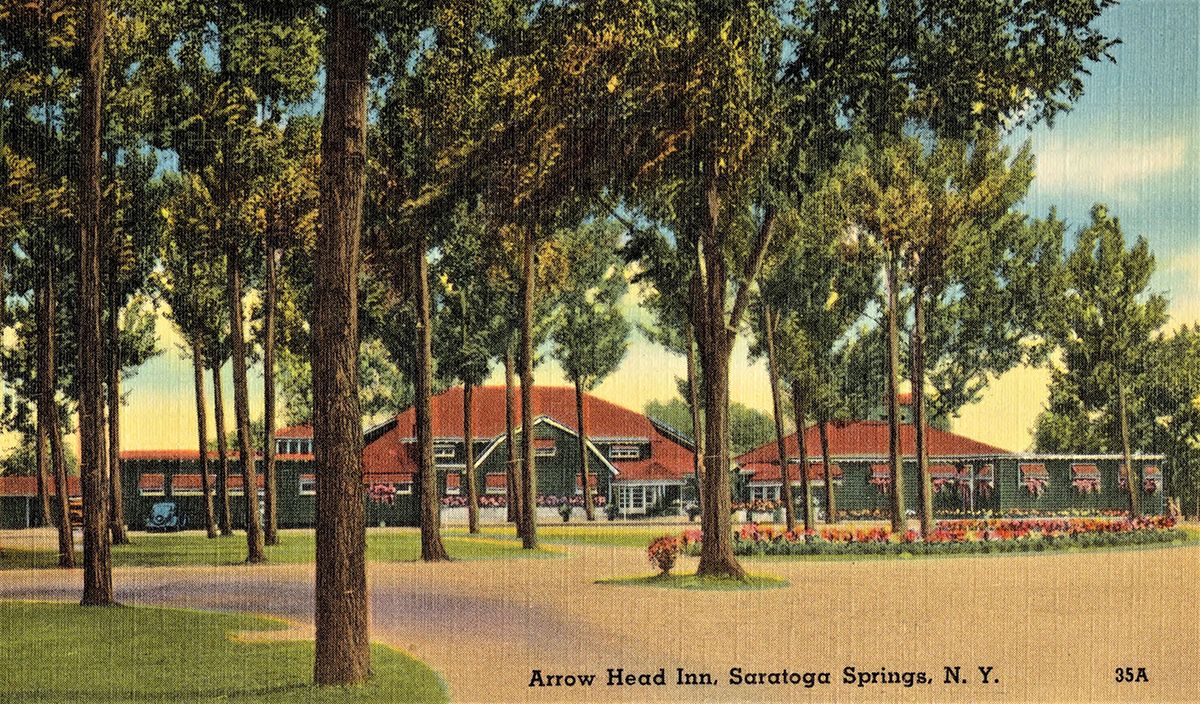
A historic postcard of the Arrowhead Inn, circa 1930-1945.
The history of the land of the Arrowhead Inn dates back to 3,000 – 1,500 B.C. It was a seasonally occupied hunting and gathering site with intermittent occupation by indigenous people, including the Mohawks. Today a portion of the land is a recognized pre-historic site listed on the National Register of Historic Places and protected as the Arrowhead Casino Archaeological Preserve.
The land was acquired from the Mohawks after a long dispute. It is believed that circa 1810 John Kock Beekman acquired the land and it became a farm. Remaining a farm through a series of owners until A. Gerald Hull, Jr. purchased it in 1887. The 50 acres he purchased was described as being in the shape of an arrowhead, hence its future name.
This is the former gambling room, note the high windows and the original bar. Photo provided by Alice Corey Photography.
Hull, who was described as a “brilliant and eccentric New Yorker,” was an orphan at a young age who received a large inheritance from his father. He built a summer home where he lived with his wife and only child. Sadly, his son died when he was two years old and his wife passed away less than three years later in 1892. In the winter of the following year, Hull moved to the Arcade Building on Broadway. On February 7th the New York Times reported that “one of Saratoga’s wealthiest and most respected citizens committed
suicide … by shooting himself in the head with a revolver.” Due to legal disputes his estate was not settled quickly.
On January 5, 1899 Benjamin C. Riley purchased the property for $6,300. He opened the first Arrowhead Inn that summer. It was there he became acquainted with all the big spenders of the day – Diamond Jim Brady; Richard Canfield, owner of the Canfield Casino, the former John Morrissey Club House, in Congress Park; John W. “Bet-a-Million” Gates; Lucky Baldwin, and others. His success led him to move to New York City and open a new Arrowhead Inn in 1907.
Harry M. Levengston, who built the Saratoga Bath House and resided at 115 Circular Street (featured in last year’s Simply Saratoga Holiday Edition), purchased the Arrowhead Inn in 1907. It continued to be a destination for fine dining during his ownership, serving “sumptuous” fish dinners under the management of Matty Cahill. Unfortunately, the Arrowhead Inn burned to the ground on May 8, 1912. Lacking adequate insurance, he sold it to James J. Welch for $4,250 on April 1, 1913.
The new two-story, bungalow style building, designed by prominent local architects Brezee & Mallory, opened on June 5, 1916. It had a dining room with two great fireplaces overlooking the lake that could seat 200 people. Upstairs there were ten hotel rooms.
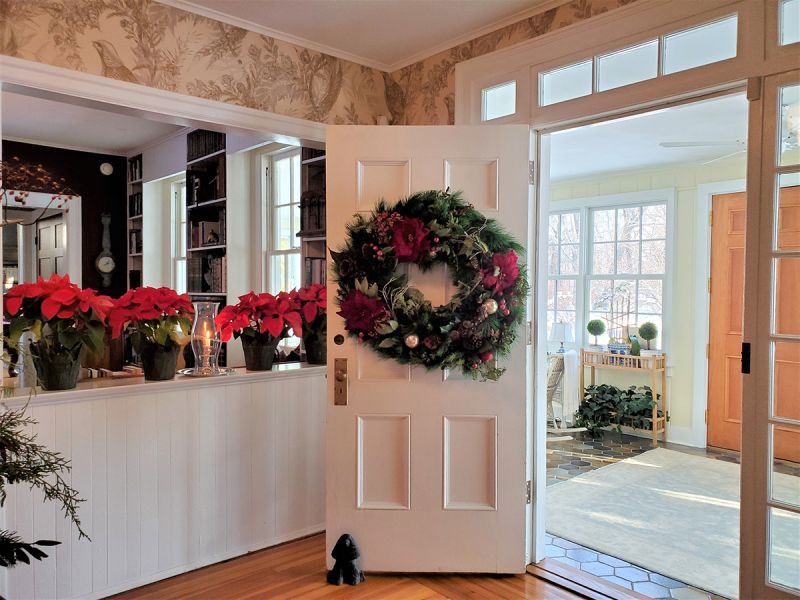
Photo provided by Saratoga Springs Preservation Foundation.
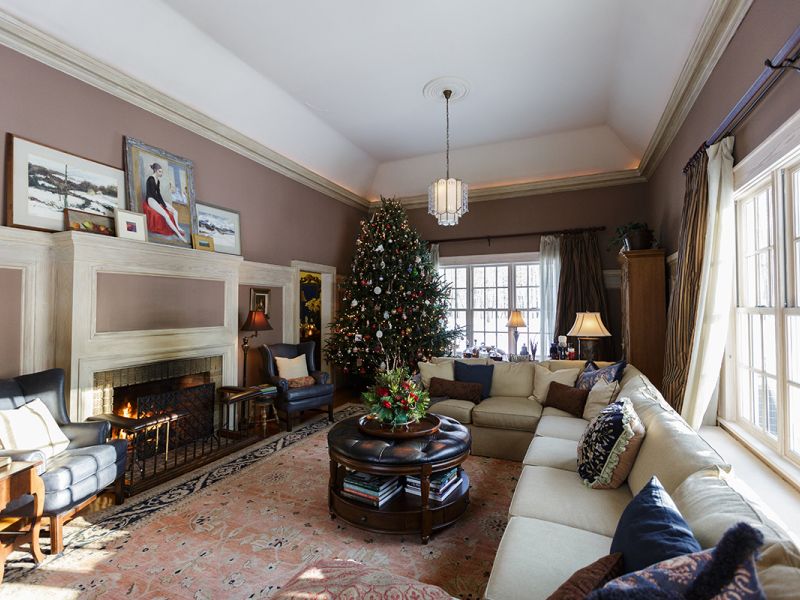
The owners restored the light fixtures in the great rooms that they discovered were from Radio City Music Hall. Photo provided by Alice Corey Photography.
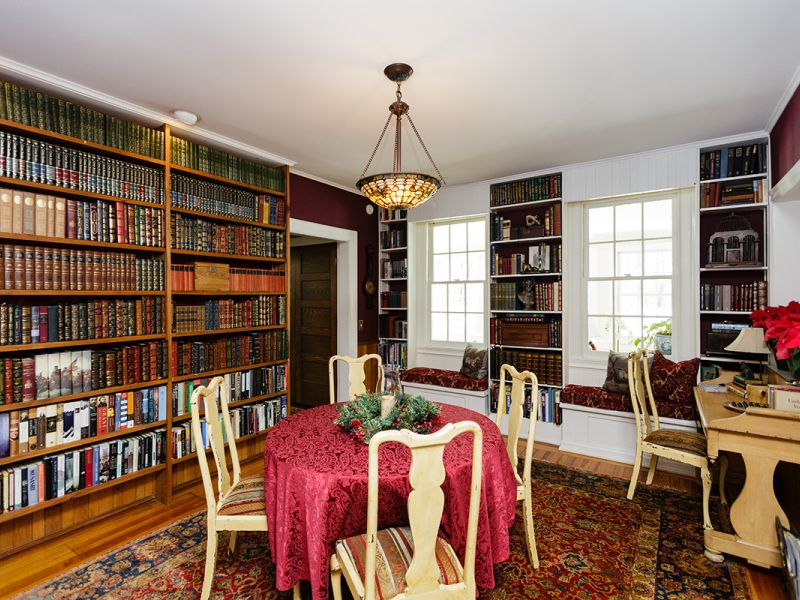
The library has an assortment of books as well as a framed Arrowhead Inn matchbooks, pictured below. Photos provided by Alice Corey Photography.

Gambling has long been a part of Saratoga’s history. It is uncertain when gambling started to take place at Arrowhead. It is possible that it took place under earlier ownership or as a result of the Prohibition negatively impacting restaurants, it may have started in 1919. It is difficult to know exactly when since gambling was illegal and not publicized.
In 1921, The Saratogian reported that two years prior a man was seen purchasing supplies for Arrowhead and 210 South Broadway. Those supplies included “three roulette wheels, a hazard table, chips and other things” as well as wine, liquors, and cigars. Welch sold the property in 1925 and the following ownership was associated with various syndicates, including Manny Cohen, Harry Winston, John Coakley, “Lefty” Clark of Detroit, Joe Adonis of Brooklyn, James “Piggy” Lynch, and Meyer Lansky, who is considered the Godfather of Godfathers. Numerous articles reported various investigations that identified gambling taking place at the Arrowhead, including armed guards standing outside.
While the gambling was not publicized, the world-class entertainment was. Entertainers included the popular orchestras led by Vincent Lopez, Paul Whiteman, Enric Madiguera, Emil Coleman, Ernie Holst, and Xavier Cugat. These orchestras often had appearances by other celebrities- Sophie Tucker, Al Jolson, Desi Arnaz, and Bing Crosby, who sang a live broadcast of “Home on the Range” the night it was announced that Will Rogers had been killed in a plane crash. Needless to say, the Arrowhead was a popular destination!
Once alcohol was made legal again in 1933, the state required that owners of gambling venues construct annexes for that activity despite it being illegal. It is that time that it is believed that the house seen today was built as the gambling annex, according to local historian Field Horne.
The Arrowhead closed during WWII, reopening in 1946. However, the future of Arrowhead, once advertised as “Saratoga’s Favorite Rendezvous,” was cut short due to U.S. Senate investigation into organized crime, later known as the Kefauver Hearings. The investigation found six roulette wheels, three craps tables, a large card table, and two bird cages, used for dice or chips.
The Arrowhead never re-opened after 1949. The widow of James Welch foreclosed on the property and A. J. Farone purchased it in 1952. The original Arrowhead building remained vacant until September 27, 1969. That day demolition of the structure started to take place. Later that afternoon a fire broke out that destroyed the building.
The private casino was made into a residence and had a series of owners until the current owners, a young couple from New York City, purchased the property in 2006. The building was clad in vinyl and nearly all of the windows had been replaced. The couple were looking to relocate to a small city to raise children. When the husband found an online listing with no photos he asked his wife to check it out on her return from scouting another small upstate community. “I wasn’t able to tour the interior – I peaked in the windows,” she shared. “I knew immediately that it was the house,” she continued.
The current owners replaced the inappropriate louvered windows of the enclosed front porch. Photo provided by Alice Corey Photography.
The house was deteriorated. The owners worked closely with Rich Martin of Northern Dean to undertake the initial rehabilitation, which took a year to complete. Working with Rich they were able to save the original plaster, moldings, floors, fireplaces, light fixtures, bar, and the commercial grade urinal and 1933 Magic Chef oven (which recently had to be replaced). The owners removed the vinyl siding and installed new cedar shake shingles and replaced the inappropriate windows, including the louvered windows that enclosed the front porch. During the project, original cisterns, a menu, poker chips, Arrowhead Inn match books, the original road sign, liquor bottles, and newspapers were found, including one that was about the Lindberg baby kidnapping. The owners have kept all of the artifacts and they are displayed throughout their home.
“The house revealed its history while the work was taking place,” said the husband. The newspapers reaffirm that it was probably built in 1932 and the chips allude to its gambling history. There was evidence that an office was located on the second floor, now the master bedroom, where a window allowed people to watch who was coming and going. Large spaces were discovered above the two great rooms that flank each side of the house with holes that looked into the rooms from above, presumably to keep an eye on the gaming. The windows of the great rooms were placed six feet above the ground to prevent people being able to see what was going on inside. There was also evidence of fire damage, most likely from when the main building burned to the ground.
The owners replaced the original commercial 1933 Magic Chef oven with an appropriate oven. Photo provided by Alice Corey Photography.
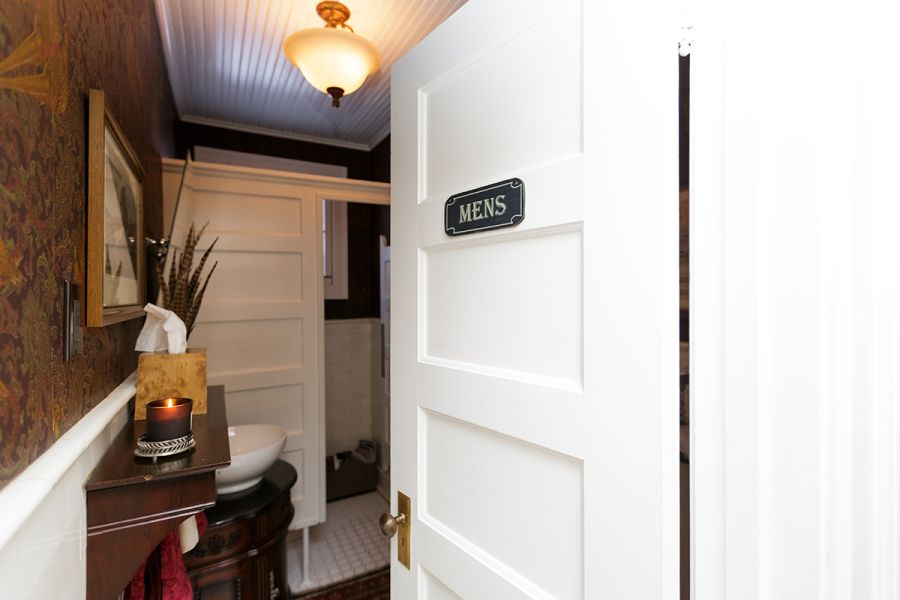
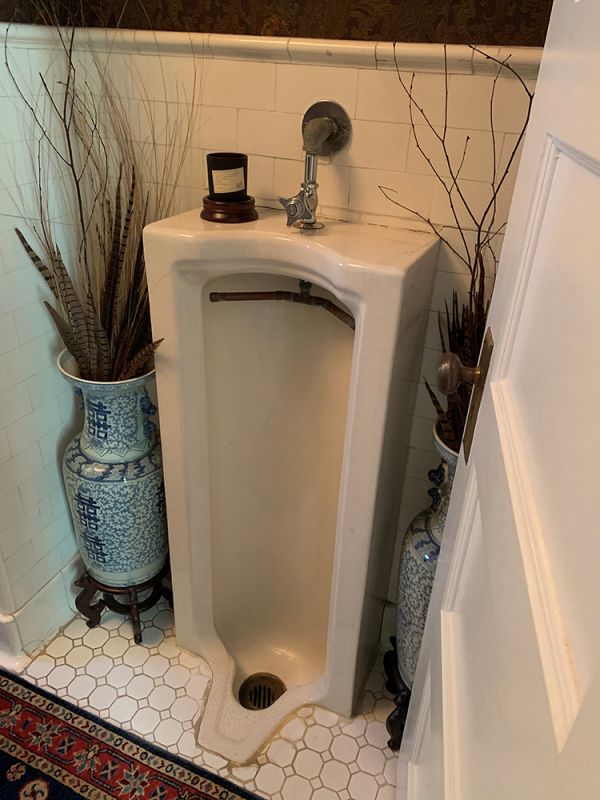
The owners retained the original men’s stall and urinal. Photos provided by Alice Corey Photography and SSPF respectively.
The owners embraced the history of the building and have enjoyed making it their own. “It has character that you can’t build, it takes time,” said the husband. “We had an eye towards preservation, but it has our fingerprints. We wanted the changes we made to seem seamless,” he continued. When each were asked separately what aspect of the house was their favorite, both responded with nearly the same answer – “That is hard to say, we and our two children use every inch of the house. Whether it be coffee on the front porch in the morning, having family dinners in the dining room with Rat Pack music playing in the background, doing school work in the library, or entertaining friends in one of the two great rooms or celebrating the holidays by the fire – we love it all, including the landscape with its many trees!”
While their initial intention was to create a home to raise children, they have become great stewards of this unique part of Saratoga’s history – the last vestige of the former lake houses. Thank you!
| Joomla! Version | 4.4.13 |
| PHP Version | 8.3.23 |
| Identity | guest |
| Response | 200 |
| Template | yootheme |
| Database |
|
| 1 x afterInitialise (1.96MB) (65.6%) | 199.65ms |
| 1 x afterRenderComponent com_content (278.13KB) (10.05%) | 30.59ms |
| 1 x beforeRenderRawModule mod_ijoomla_adagency_zone (Home_Center_Banner_Right_Zone) (1.95MB) (8.04%) | 24.45ms |
| 1 x beforeRenderRawModule mod_finder () (83.53KB) (5.98%) | 18.20ms |
| 1 x afterRenderRawModule mod_ijoomla_adagency_zone (Home_Center_Banner_Right_Zone) (901.34KB) (2.35%) | 7.16ms |
| 1 x afterRenderRawModule mod_finder () (1.79MB) (1.31%) | 3.98ms |
| 1 x afterRoute (375.98KB) (0.96%) | 2.92ms |
| 1 x afterRender (274.22KB) (0.81%) | 2.47ms |
| 1 x beforeRenderRawModule mod_ijoomla_adagency_zone (Good_Read_Center_Banner_Zone ) (87.08KB) (0.59%) | 1.81ms |
| 1 x afterLoad (444.85KB) (0.57%) | 1.73ms |
| 1 x afterRenderRawModule mod_ijoomla_adagency_zone (Good_Read_Center_Banner_Zone ) (153.35KB) (0.46%) | 1.39ms |
| 1 x After Access::preloadPermissions (com_content) (527.41KB) (0.39%) | 1.18ms |
| 1 x afterRenderRawModule mod_custom () (319.79KB) (0.3%) | 916μs |
| 1 x Before Access::preloadComponents (all components) (47.72KB) (0.26%) | 785μs |
| 1 x afterDispatch (17.39KB) (0.25%) | 750μs |
| 1 x After Access::preloadComponents (all components) (116.7KB) (0.2%) | 619μs |
| 1 x beforeRenderComponent com_content (49.07KB) (0.19%) | 569μs |
| 1 x afterRenderRawModule mod_menu () (12.02KB) (0.18%) | 535μs |
| 1 x afterRenderRawModule mod_finder () (7.28KB) (0.16%) | 482μs |
| 1 x afterRenderRawModule mod_menu () (3.2KB) (0.12%) | 354μs |
| 1 x afterRenderRawModule mod_menu () (1.79KB) (0.11%) | 330μs |
| 1 x afterRenderModule mod_ijoomla_adagency_zone (Home_Center_Banner_Right_Zone) (6.92KB) (0.07%) | 224μs |
| 2 x afterRenderRawModule mod_custom () (1008B) (0.07%) | 203μs |
| 2 x afterRenderModule mod_finder () (1.34KB) (0.06%) | 179μs |
| 1 x beforeRenderRawModule mod_menu () (1.66KB) (0.06%) | 174μs |
| 1 x beforeRenderRawModule mod_custom () (6.27KB) (0.05%) | 153μs |
| 2 x afterRenderModule mod_menu () (2.76KB) (0.04%) | 120μs |
| 1 x afterRenderRawModule mod_custom () (1.03KB) (0.04%) | 119μs |
| 2 x beforeRenderRawModule mod_custom () (920B) (0.04%) | 118μs |
| 1 x afterRenderRawModule mod_custom () (912B) (0.04%) | 113μs |
| 2 x afterRenderModule mod_custom () (1.23KB) (0.04%) | 112μs |
| 1 x beforeRenderRawModule mod_menu () (24B) (0.03%) | 88μs |
| 1 x afterRenderModule mod_ijoomla_adagency_zone (Good_Read_Center_Banner_Zone ) (4.06KB) (0.02%) | 74μs |
| 1 x afterRenderModule mod_menu () (1.34KB) (0.02%) | 71μs |
| 1 x beforeRenderRawModule mod_menu () (1.8KB) (0.02%) | 70μs |
| 1 x afterRenderModule mod_custom () (3.15KB) (0.02%) | 63μs |
| 1 x afterRenderModule mod_custom () (2.77KB) (0.02%) | 58μs |
| 1 x After Access::getAssetRules (id:203 name:com_content.article.50) (7.38KB) (0.02%) | 54μs |
| 1 x beforeRenderRawModule mod_custom () (472B) (0.02%) | 52μs |
| 1 x afterRenderModule mod_custom () (2.43KB) (0.01%) | 39μs |
| 1 x Before Access::getAssetRules (id:203 name:com_content.article.50) (18.65KB) (0.01%) | 26μs |
| 5 x beforeRenderModule mod_custom () (704B) (0%) | 15μs |
| 1 x Before Access::preloadPermissions (com_content) (1.63KB) (0%) | 12μs |
| 3 x beforeRenderModule mod_menu () (696B) (0%) | 10μs |
| 1 x beforeRenderRawModule mod_finder () (96B) (0%) | 8μs |
| 1 x beforeRenderRawModule mod_custom () (288B) (0%) | 8μs |
| 2 x beforeRenderModule mod_finder () (704B) (0%) | 7μs |
| 1 x beforeRenderModule mod_ijoomla_adagency_zone (Home_Center_Banner_Right_Zone) (752B) (0%) | 5μs |
| 1 x beforeRenderModule mod_ijoomla_adagency_zone (Good_Read_Center_Banner_Zone ) (752B) (0%) | 4μs |
SELECT @@SESSION.sql_mode;78μs968B/libraries/vendor/joomla/database/src/Mysqli/MysqliDriver.php:334CopySELECT `data`
FROM `jos_session`
WHERE `session_id` = ?125μs1008BParams/libraries/vendor/joomla/session/src/Handler/DatabaseHandler.php:261CopySELECT `session_id`
FROM `jos_session`
WHERE `session_id` = :session_id LIMIT 178μs1.3KBParams/libraries/src/Session/MetadataManager.php:187CopyINSERT INTO `jos_session`
(`session_id`,`guest`,`time`,`userid`,`username`,`client_id`) VALUES
(:session_id, :guest, :time, :user_id, :username, :client_id)180ms944BParams/libraries/src/Session/MetadataManager.php:260CopySELECT `id`,`rules`
FROM `jos_viewlevels`112μs976B/libraries/src/Access/Access.php:955CopySELECT `b`.`id`
FROM `jos_usergroups` AS `a`
LEFT JOIN `jos_usergroups` AS `b` ON `b`.`lft` <= `a`.`lft` AND `b`.`rgt` >= `a`.`rgt`
WHERE `a`.`id` = :guest206μs1.33KBParams/libraries/src/Access/Access.php:868CopySELECT e.enabled
FROM jos_extensions AS e
WHERE e.element = "com_k2" AND e.type = "component"127μs520B/administrator/components/com_tagz/helpers/tagz.php:890CopySELECT e.enabled
FROM jos_extensions AS e
WHERE e.element = "com_virtuemart" AND e.type = "component"97μs520B/administrator/components/com_tagz/helpers/tagz.php:890CopySELECT e.enabled
FROM jos_extensions AS e
WHERE e.element = "com_easyblog" AND e.type = "component"79μs1.13KB/administrator/components/com_tagz/helpers/tagz.php:890CopySELECT e.enabled
FROM jos_extensions AS e
WHERE e.element = "com_jomclassifieds" AND e.type = "component"77μs520B/administrator/components/com_tagz/helpers/tagz.php:890CopySELECT e.enabled
FROM jos_extensions AS e
WHERE e.element = "com_hikashop" AND e.type = "component"105μs520B/administrator/components/com_tagz/helpers/tagz.php:890CopySELECT e.enabled
FROM jos_extensions AS e
WHERE e.element = "com_rseventspro" AND e.type = "component"79μs520B/administrator/components/com_tagz/helpers/tagz.php:890CopySELECT e.enabled
FROM jos_extensions AS e
WHERE e.element = "com_zoo" AND e.type = "component"82μs536B/administrator/components/com_tagz/helpers/tagz.php:890CopySELECT e.enabled
FROM jos_extensions AS e
WHERE e.element = "com_jticketing" AND e.type = "component"59μs520B/administrator/components/com_tagz/helpers/tagz.php:890CopySELECT e.enabled
FROM jos_extensions AS e
WHERE e.element = "com_icagenda" AND e.type = "component"56μs520B/administrator/components/com_tagz/helpers/tagz.php:890CopySELECT e.enabled
FROM jos_extensions AS e
WHERE e.element = "com_eventbooking" AND e.type = "component"67μs520B/administrator/components/com_tagz/helpers/tagz.php:890CopySELECT e.enabled
FROM jos_extensions AS e
WHERE e.element = "com_eshop" AND e.type = "component"54μs1.76KB/administrator/components/com_tagz/helpers/tagz.php:890CopySELECT e.enabled
FROM jos_extensions AS e
WHERE e.element = "com_rsblog" AND e.type = "component"72μs520B/administrator/components/com_tagz/helpers/tagz.php:890CopySELECT e.enabled
FROM jos_extensions AS e
WHERE e.element = "com_mijovideos" AND e.type = "component"54μs520B/administrator/components/com_tagz/helpers/tagz.php:890CopySELECT e.enabled
FROM jos_extensions AS e
WHERE e.element = "com_opencart" AND e.type = "component"64μs520B/administrator/components/com_tagz/helpers/tagz.php:890CopySELECT e.enabled
FROM jos_extensions AS e
WHERE e.element = "com_jcart" AND e.type = "component"56μs520B/administrator/components/com_tagz/helpers/tagz.php:890CopySELECT e.enabled
FROM jos_extensions AS e
WHERE e.element = "com_djclassifieds" AND e.type = "component"53μs520B/administrator/components/com_tagz/helpers/tagz.php:890CopySELECT e.enabled
FROM jos_extensions AS e
WHERE e.element = "com_j2store" AND e.type = "component"51μs520B/administrator/components/com_tagz/helpers/tagz.php:890CopySELECT e.enabled
FROM jos_extensions AS e
WHERE e.element = "com_phocacart" AND e.type = "component"66μs520B/administrator/components/com_tagz/helpers/tagz.php:890CopySELECT e.enabled
FROM jos_extensions AS e
WHERE e.element = "com_jshopping" AND e.type = "component"57μs520B/administrator/components/com_tagz/helpers/tagz.php:890CopySELECT e.enabled
FROM jos_extensions AS e
WHERE e.element = "com_igallery" AND e.type = "component"56μs520B/administrator/components/com_tagz/helpers/tagz.php:890CopySELECT e.enabled
FROM jos_extensions AS e
WHERE e.element = "com_dpcalendar" AND e.type = "component"68μs520B/administrator/components/com_tagz/helpers/tagz.php:890CopySHOW FULL COLUMNS FROM `jos_tagz_config`412μs1.3KB/libraries/vendor/joomla/database/src/Mysqli/MysqliDriver.php:625CopySELECT *
FROM `jos_tagz_config`
WHERE `name` = 'config'80μs592B/libraries/src/Table/Table.php:755CopySELECT id,template FROM jos_template_styles WHERE client_id=0 AND home=196μs592B/administrator/components/com_widgetkit/widgetkit.php:28CopySELECT custom_data
FROM jos_extensions
WHERE element = 'yooessentials' AND folder = 'system'83μs536B/plugins/system/yooessentials/helper.php:153CopySELECT custom_data FROM jos_extensions WHERE element = 'yooessentials' AND folder = 'system' LIMIT 189μs536B/plugins/system/yooessentials/modules/platform-joomla/src/Database.php:52CopySELECT `id`,`name`,`rules`,`parent_id`
FROM `jos_assets`
WHERE `name` IN (:preparedArray1,:preparedArray2,:preparedArray3,:preparedArray4,:preparedArray5,:preparedArray6,:preparedArray7,:preparedArray8,:preparedArray9,:preparedArray10,:preparedArray11,:preparedArray12,:preparedArray13,:preparedArray14,:preparedArray15,:preparedArray16,:preparedArray17,:preparedArray18,:preparedArray19,:preparedArray20,:preparedArray21,:preparedArray22,:preparedArray23,:preparedArray24,:preparedArray25,:preparedArray26,:preparedArray27,:preparedArray28,:preparedArray29,:preparedArray30,:preparedArray31,:preparedArray32,:preparedArray33,:preparedArray34,:preparedArray35,:preparedArray36,:preparedArray37,:preparedArray38,:preparedArray39,:preparedArray40,:preparedArray41)357μs9.94KBParams/libraries/src/Access/Access.php:357CopySELECT `id`,`name`,`rules`,`parent_id`
FROM `jos_assets`
WHERE `name` LIKE :asset OR `name` = :extension OR `parent_id` = 0482μs49.48KBParams/libraries/src/Access/Access.php:301CopySHOW FULL COLUMNS FROM `jos_content`516μs1.77KB/libraries/vendor/joomla/database/src/Mysqli/MysqliDriver.php:625CopyUPDATE `jos_content`
SET `hits` = (`hits` + 1)
WHERE `id` = '50'563μs48B/libraries/src/Table/Table.php:1325CopySELECT `a`.`id`,`a`.`asset_id`,`a`.`title`,`a`.`alias`,`a`.`introtext`,`a`.`fulltext`,`a`.`state`,`a`.`catid`,`a`.`created`,`a`.`created_by`,`a`.`created_by_alias`,`a`.`modified`,`a`.`modified_by`,`a`.`checked_out`,`a`.`checked_out_time`,`a`.`publish_up`,`a`.`publish_down`,`a`.`images`,`a`.`urls`,`a`.`attribs`,`a`.`version`,`a`.`ordering`,`a`.`metakey`,`a`.`metadesc`,`a`.`access`,`a`.`hits`,`a`.`metadata`,`a`.`featured`,`a`.`language`,`fp`.`featured_up`,`fp`.`featured_down`,`c`.`title` AS `category_title`,`c`.`alias` AS `category_alias`,`c`.`access` AS `category_access`,`c`.`language` AS `category_language`,`fp`.`ordering`,`u`.`name` AS `author`,`parent`.`title` AS `parent_title`,`parent`.`id` AS `parent_id`,`parent`.`path` AS `parent_route`,`parent`.`alias` AS `parent_alias`,`parent`.`language` AS `parent_language`,ROUND(`v`.`rating_sum` / `v`.`rating_count`, 1) AS `rating`,`v`.`rating_count` AS `rating_count`
FROM `jos_content` AS `a`
INNER JOIN `jos_categories` AS `c` ON `c`.`id` = `a`.`catid`
LEFT JOIN `jos_content_frontpage` AS `fp` ON `fp`.`content_id` = `a`.`id`
LEFT JOIN `jos_users` AS `u` ON `u`.`id` = `a`.`created_by`
LEFT JOIN `jos_categories` AS `parent` ON `parent`.`id` = `c`.`parent_id`
LEFT JOIN `jos_content_rating` AS `v` ON `a`.`id` = `v`.`content_id`
WHERE
(
(`a`.`id` = :pk AND `c`.`published` > 0) AND
(`a`.`publish_up` IS NULL OR `a`.`publish_up` <= :publishUp)) AND
(`a`.`publish_down` IS NULL OR `a`.`publish_down` >= :publishDown) AND `a`.`state` IN (:preparedArray1,:preparedArray2)360μs102.13KBParams/components/com_content/src/Model/ArticleModel.php:215CopySELECT `c`.`id`,`c`.`asset_id`,`c`.`access`,`c`.`alias`,`c`.`checked_out`,`c`.`checked_out_time`,`c`.`created_time`,`c`.`created_user_id`,`c`.`description`,`c`.`extension`,`c`.`hits`,`c`.`language`,`c`.`level`,`c`.`lft`,`c`.`metadata`,`c`.`metadesc`,`c`.`metakey`,`c`.`modified_time`,`c`.`note`,`c`.`params`,`c`.`parent_id`,`c`.`path`,`c`.`published`,`c`.`rgt`,`c`.`title`,`c`.`modified_user_id`,`c`.`version`, CASE WHEN CHAR_LENGTH(`c`.`alias`) != 0 THEN CONCAT_WS(':', `c`.`id`, `c`.`alias`) ELSE `c`.`id` END as `slug`
FROM `jos_categories` AS `s`
INNER JOIN `jos_categories` AS `c` ON (`s`.`lft` <= `c`.`lft` AND `c`.`lft` < `s`.`rgt`) OR (`c`.`lft` < `s`.`lft` AND `s`.`rgt` < `c`.`rgt`)
WHERE (`c`.`extension` = :extension OR `c`.`extension` = 'system') AND `c`.`access` IN (:preparedArray1,:preparedArray2) AND `c`.`published` = 1 AND `s`.`id` = :id
ORDER BY `c`.`lft`377μs3.91KBParams/libraries/src/Categories/Categories.php:375CopySELECT `m`.`tag_id`,`t`.*
FROM `jos_contentitem_tag_map` AS `m`
INNER JOIN `jos_tags` AS `t` ON `m`.`tag_id` = `t`.`id`
WHERE `m`.`type_alias` = :contentType AND `m`.`content_item_id` = :id AND `t`.`published` = 1 AND `t`.`access` IN (:preparedArray1,:preparedArray2)165μs3.97KBParams/libraries/src/Helper/TagsHelper.php:388CopySELECT `c`.`id`,`c`.`asset_id`,`c`.`access`,`c`.`alias`,`c`.`checked_out`,`c`.`checked_out_time`,`c`.`created_time`,`c`.`created_user_id`,`c`.`description`,`c`.`extension`,`c`.`hits`,`c`.`language`,`c`.`level`,`c`.`lft`,`c`.`metadata`,`c`.`metadesc`,`c`.`metakey`,`c`.`modified_time`,`c`.`note`,`c`.`params`,`c`.`parent_id`,`c`.`path`,`c`.`published`,`c`.`rgt`,`c`.`title`,`c`.`modified_user_id`,`c`.`version`, CASE WHEN CHAR_LENGTH(`c`.`alias`) != 0 THEN CONCAT_WS(':', `c`.`id`, `c`.`alias`) ELSE `c`.`id` END as `slug`
FROM `jos_categories` AS `s`
INNER JOIN `jos_categories` AS `c` ON (`s`.`lft` <= `c`.`lft` AND `c`.`lft` < `s`.`rgt`) OR (`c`.`lft` < `s`.`lft` AND `s`.`rgt` < `c`.`rgt`)
WHERE (`c`.`extension` = :extension OR `c`.`extension` = 'system') AND `c`.`access` IN (:preparedArray1,:preparedArray2) AND `c`.`published` = 1 AND `s`.`id` = :id
ORDER BY `c`.`lft`924μs3.91KBParams/libraries/src/Categories/Categories.php:375CopySELECT DISTINCT a.id, a.title, a.name, a.checked_out, a.checked_out_time, a.note, a.state, a.access, a.created_time, a.created_user_id, a.ordering, a.language, a.fieldparams, a.params, a.type, a.default_value, a.context, a.group_id, a.label, a.description, a.required, a.only_use_in_subform,l.title AS language_title, l.image AS language_image,uc.name AS editor,ag.title AS access_level,ua.name AS author_name,g.title AS group_title, g.access as group_access, g.state AS group_state, g.note as group_note
FROM jos_fields AS a
LEFT JOIN `jos_languages` AS l ON l.lang_code = a.language
LEFT JOIN jos_users AS uc ON uc.id=a.checked_out
LEFT JOIN jos_viewlevels AS ag ON ag.id = a.access
LEFT JOIN jos_users AS ua ON ua.id = a.created_user_id
LEFT JOIN jos_fields_groups AS g ON g.id = a.group_id
LEFT JOIN `jos_fields_categories` AS fc ON fc.field_id = a.id
WHERE
(
(`a`.`context` = :context AND (`fc`.`category_id` IS NULL OR `fc`.`category_id` IN (:preparedArray1,:preparedArray2)) AND `a`.`access` IN (:preparedArray3,:preparedArray4)) AND
(`a`.`group_id` = 0 OR `g`.`access` IN (:preparedArray5,:preparedArray6)) AND `a`.`state` = :state) AND
(`a`.`group_id` = 0 OR `g`.`state` = :gstate) AND `a`.`only_use_in_subform` = :only_use_in_subform
ORDER BY a.ordering ASC262μs4.75KBParams/libraries/src/MVC/Model/BaseDatabaseModel.php:166Copyselect `blacklist` from jos_ad_agency_settings79μs536B/modules/mod_ijoomla_adagency_zone/helper.php:2043Copyselect `params` from jos_ad_agency_settings44μs536B/modules/mod_ijoomla_adagency_zone/helper.php:74CopySELECT * FROM jos_ad_agency_settings LIMIT 1171μs65.5KB/modules/mod_ijoomla_adagency_zone/helper.php:100CopySELECT * FROM jos_ad_agency_zone WHERE zoneid=146 LIMIT 1106μs3KB/modules/mod_ijoomla_adagency_zone/helper.php:104Copyselect `approved` from jos_ad_agency_banners where `id`=054μs520B/modules/mod_ijoomla_adagency_zone/helper.php:121Copyselect `approved` from jos_ad_agency_banners where `id`=031μs0B/modules/mod_ijoomla_adagency_zone/helper.php:122Copydelete from jos_ad_agency_ips where `entry_date` <= '2025-08-11'102μs0B/modules/mod_ijoomla_adagency_zone/tmpl/default.php:16CopySELECT * FROM jos_ad_agency_zone WHERE zoneid=146 LIMIT 175μs3KB/modules/mod_ijoomla_adagency_zone/tmpl/default.php:20Copyselect `params` from jos_ad_agency_settings53μs536B/modules/mod_ijoomla_adagency_zone/tmpl/default.php:48Copyselect `blacklist` from jos_ad_agency_settings46μs536B/modules/mod_ijoomla_adagency_zone/helper.php:2043Copyselect `params` from jos_ad_agency_settings34μs536B/modules/mod_ijoomla_adagency_zone/helper.php:74CopySELECT * FROM jos_ad_agency_settings LIMIT 1134μs65.5KB/modules/mod_ijoomla_adagency_zone/helper.php:100CopySELECT * FROM jos_ad_agency_zone WHERE zoneid=174 LIMIT 166μs3KB/modules/mod_ijoomla_adagency_zone/helper.php:104Copyselect `approved` from jos_ad_agency_banners where `id`=036μs520B/modules/mod_ijoomla_adagency_zone/helper.php:121Copyselect `approved` from jos_ad_agency_banners where `id`=027μs0B/modules/mod_ijoomla_adagency_zone/helper.php:122Copydelete from jos_ad_agency_ips where `entry_date` <= '2025-08-11'66μs0B/modules/mod_ijoomla_adagency_zone/tmpl/default.php:16CopySELECT * FROM jos_ad_agency_zone WHERE zoneid=174 LIMIT 183μs3KB/modules/mod_ijoomla_adagency_zone/tmpl/default.php:20Copyselect `params` from jos_ad_agency_settings36μs536B/modules/mod_ijoomla_adagency_zone/tmpl/default.php:48CopySELECT `a`.`id`,`a`.`title`,`a`.`catid`,`a`.`language`, CASE WHEN CHAR_LENGTH(`a`.`alias`) != 0 THEN CONCAT_WS(':', `a`.`id`, `a`.`alias`) ELSE a.id END AS `slug`, CASE WHEN CHAR_LENGTH(`cc`.`alias`) != 0 THEN CONCAT_WS(':', `cc`.`id`, `cc`.`alias`) ELSE cc.id END AS `catslug`
FROM `jos_content` AS `a`
LEFT JOIN `jos_categories` AS `cc` ON `cc`.`id` = `a`.`catid`
WHERE `a`.`catid` = :catid AND `a`.`state` = :state AND `a`.`access` IN (:preparedArray1,:preparedArray2) AND (`publish_up` IS NULL OR `publish_up` <= :nowDate1) AND (`publish_down` IS NULL OR `publish_down` >= :nowDate2)
ORDER BY CASE WHEN `a`.`publish_up` IS NULL THEN `a`.`created` ELSE `a`.`publish_up` END DESC15.78ms41.72KBParams/plugins/content/pagenavigation/src/Extension/PageNavigation.php:188CopySELECT `c`.`id`,`c`.`asset_id`,`c`.`access`,`c`.`alias`,`c`.`checked_out`,`c`.`checked_out_time`,`c`.`created_time`,`c`.`created_user_id`,`c`.`description`,`c`.`extension`,`c`.`hits`,`c`.`language`,`c`.`level`,`c`.`lft`,`c`.`metadata`,`c`.`metadesc`,`c`.`metakey`,`c`.`modified_time`,`c`.`note`,`c`.`params`,`c`.`parent_id`,`c`.`path`,`c`.`published`,`c`.`rgt`,`c`.`title`,`c`.`modified_user_id`,`c`.`version`, CASE WHEN CHAR_LENGTH(`c`.`alias`) != 0 THEN CONCAT_WS(':', `c`.`id`, `c`.`alias`) ELSE `c`.`id` END as `slug`
FROM `jos_categories` AS `s`
INNER JOIN `jos_categories` AS `c` ON (`s`.`lft` <= `c`.`lft` AND `c`.`lft` < `s`.`rgt`) OR (`c`.`lft` < `s`.`lft` AND `s`.`rgt` < `c`.`rgt`)
WHERE (`c`.`extension` = :extension OR `c`.`extension` = 'system') AND `c`.`access` IN (:preparedArray1,:preparedArray2) AND `c`.`published` = 1 AND `s`.`id` = :id
ORDER BY `c`.`lft`444μs3.91KBParams/libraries/src/Categories/Categories.php:375CopySELECT `params`
FROM `jos_tagz`
WHERE `component_id` = 123 AND `component_type` = "menu"206μs520B/plugins/system/tagz/tagz.php:650CopySELECT `params`
FROM `jos_tagz`
WHERE `component_id` = 50 AND `component_type` = "content"141μs536B/plugins/system/tagz/tagz.php:650CopySELECT `name`,`element`
FROM `jos_extensions`
WHERE `type` = 'plugin' AND `folder` = 'finder' AND `enabled` = 1246μs592B/administrator/components/com_finder/src/Helper/LanguageHelper.php:135CopySELECT `title`
FROM `jos_finder_taxonomy`
WHERE `parent_id` = 1 AND `state` = 1 AND `access` IN (1,5)111μs11.57KB/administrator/components/com_finder/src/Indexer/Taxonomy.php:314CopySELECT custom_data FROM jos_extensions WHERE element = 'yootheme' AND folder = 'system' LIMIT 1293μs688.52KB/templates/yootheme/packages/platform-joomla/src/Storage.php:30CopySELECT DISTINCT a.id, a.title, a.name, a.checked_out, a.checked_out_time, a.note, a.state, a.access, a.created_time, a.created_user_id, a.ordering, a.language, a.fieldparams, a.params, a.type, a.default_value, a.context, a.group_id, a.label, a.description, a.required, a.only_use_in_subform,l.title AS language_title, l.image AS language_image,uc.name AS editor,ag.title AS access_level,ua.name AS author_name,g.title AS group_title, g.access as group_access, g.state AS group_state, g.note as group_note
FROM jos_fields AS a
LEFT JOIN `jos_languages` AS l ON l.lang_code = a.language
LEFT JOIN jos_users AS uc ON uc.id=a.checked_out
LEFT JOIN jos_viewlevels AS ag ON ag.id = a.access
LEFT JOIN jos_users AS ua ON ua.id = a.created_user_id
LEFT JOIN jos_fields_groups AS g ON g.id = a.group_id
WHERE
(
(`a`.`context` = :context AND `a`.`access` IN (:preparedArray1,:preparedArray2)) AND
(`a`.`group_id` = 0 OR `g`.`access` IN (:preparedArray3,:preparedArray4)) AND `a`.`state` = :state) AND
(`a`.`group_id` = 0 OR `g`.`state` = :gstate) AND `a`.`only_use_in_subform` = :only_use_in_subform
ORDER BY a.ordering ASC291μs4.06KBParams/libraries/src/MVC/Model/BaseDatabaseModel.php:166CopySELECT `title`
FROM `jos_finder_taxonomy`
WHERE `parent_id` = 1 AND `state` = 1 AND `access` IN (1,5)116μs584B/administrator/components/com_finder/src/Indexer/Taxonomy.php:314CopySELECT SUM(CASE WHEN `a`.`next_execution` <= :now THEN 1 ELSE 0 END) AS due_count,SUM(CASE WHEN `a`.`locked` IS NULL THEN 0 ELSE 1 END) AS locked_count
FROM `jos_scheduler_tasks` AS `a`
WHERE `a`.`state` = 191μs1.37KBParams/administrator/components/com_scheduler/src/Model/TasksModel.php:517CopySELECT `session_id`
FROM `jos_session`
WHERE `session_id` = ?90μs1KBParams/libraries/vendor/joomla/session/src/Handler/DatabaseHandler.php:291CopyUPDATE `jos_session`
SET `data` = ?
, `time` = ?
WHERE `session_id` = ?194μs592BParams/libraries/vendor/joomla/session/src/Handler/DatabaseHandler.php:318Copy